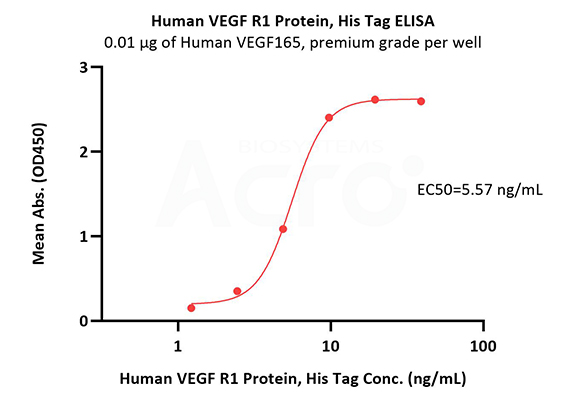
Leave message
Can’t find what you’re looking for?
Fill out this form to inquire about our custom protein services!
Inquire about our Custom Services >>


































 Limited Edition Golden Llama is here! Check out how you can get one.
Limited Edition Golden Llama is here! Check out how you can get one.  Limited Edition Golden Llama is here! Check out how you can get one.
Limited Edition Golden Llama is here! Check out how you can get one.
 Offering SPR-BLI Services - Proteins provided for free!
Offering SPR-BLI Services - Proteins provided for free! Get your ComboX free sample to test now!
Get your ComboX free sample to test now!
 Time Limited Offer: Welcome Gift for New Customers !
Time Limited Offer: Welcome Gift for New Customers !  Shipping Price Reduction for EU Regions
Shipping Price Reduction for EU Regions
> VEGF: Cortar el canal de alimentación del tumor

No solo el factor de crecimiento endotelial vascular (VEGF) desempeña un papel en la promoción de la angiogénesis y la regeneración, sino que también muestra múltiples funciones, como la regulación inmunitaria y la neuroprotección. Los miembros de la familia VEGF ejercen sus efectos a través de interacciones con una familia de tres receptores VEGF. VEGF se regula cuando se sobreexpresa en muchos tumores. Por lo tanto, se convierte en un objetivo candente del desarrollo de fármacos para tumores.
Actualmente, hay más de 100 medicamentos de anticuerpos, como los anticuerpos monoclonales (mAb) y los anticuerpos biespecíficos (BsAb) contra VEGF, que se usan ampliamente para el tratamiento clínico.
Given its significant role in multiple cancer types, including tumors, intraocular neovascular disorders and other cardiovascular diseases, there is no surprise that VEGF has been heavily studied for new target therapeutics.
ACROBiosystems ha desarrollado una variedad de proteínas VEGF con diferentes moléculas, subtipos, especies y etiquetas para ayudar a acelerar el desarrollo de fármacos de anticuerpos. Todos los protocolos SPR&BLI están disponibles de forma gratuita.
VEGF-A
VEGF-B
VEGF-C
VEGF-D
VEGF R1
VEGF R2
VEGF R3
| Molecule | Cat. No. | Species | Product Description | Structure |
|---|
| Molecule | Cat. No. | Species | Product Description | Structure |
|---|
| Molecule | Cat. No. | Species | Product Description | Structure |
|---|
| Molecule | Cat. No. | Species | Product Description | Structure |
|---|
| Molecule | Cat. No. | Species | Product Description | Structure |
|---|
| Molecule | Cat. No. | Species | Product Description | Structure |
|---|
| Molecule | Cat. No. | Species | Product Description | Structure |
|---|
>>> Si tiene alguna pregunta, sugerencia o comentario sobre VEGF, contáctenos.
>>> Haga clic aquí para conocer más objetivos principales para los anticuerpos biespecíficos.

The purity of ActiveMax® Human VEGF165, Tag Free (MALS verified) (Cat. No. VE5-H4210) is more than 95% in HP-SEC, and the molecular weight of this protein is around 40-55 kDa verified by SEC-MALS.
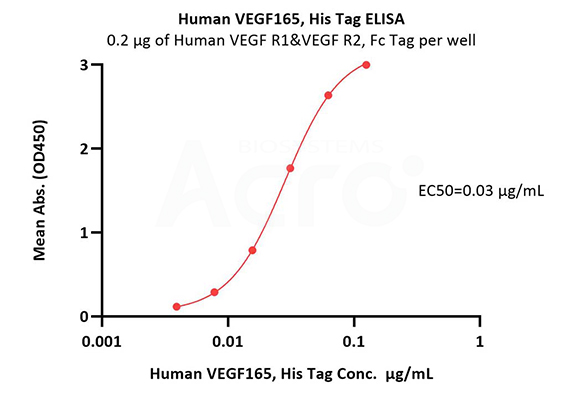
Immobilized Human VEGF R1&VEGF R2, Fc Tag at 2 μg/mL (100 μL/well) can bind Human VEGF165, His Tag (Cat. No. VE5-H5248) with a linear range of 0.004-0.063 μg/mL (QC tested).
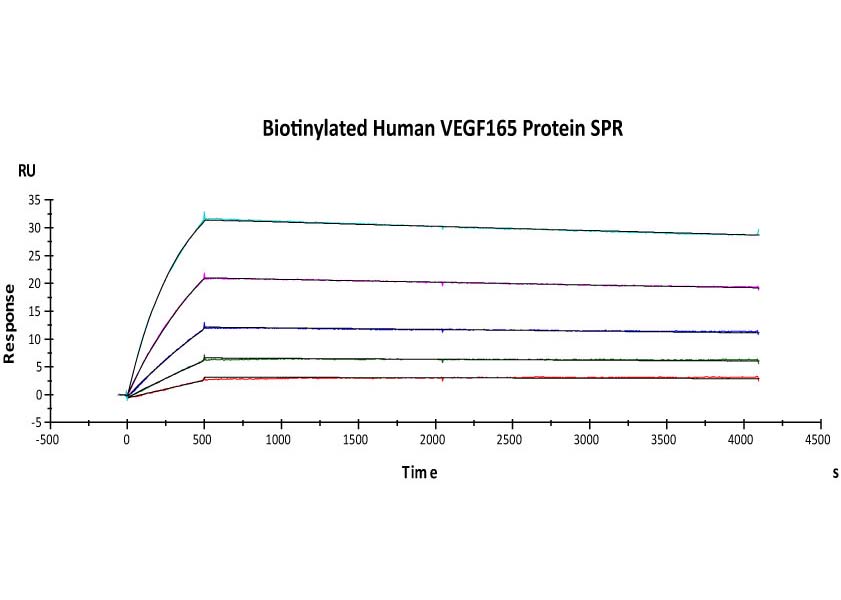
Immobilized Biotinylated Human VEGF165, His,Avitag (Cat. No. VE5-H82Q0) on CM5 Chip via Streptavidin, can bind Avastin with an affinity constant of 0.417 nM as determined in SPR assay (Biacore T200) (Routinely tested).

Loaded Avastin (Bevaciz*mab) on AHC Biosensor, can bind Human VEGF165, His Tag (Cat. No. VE5-H5248) with an affinity constant of 0.448 nM as determined in BLI assay (ForteBio Octet Red96e) (Routinely tested).
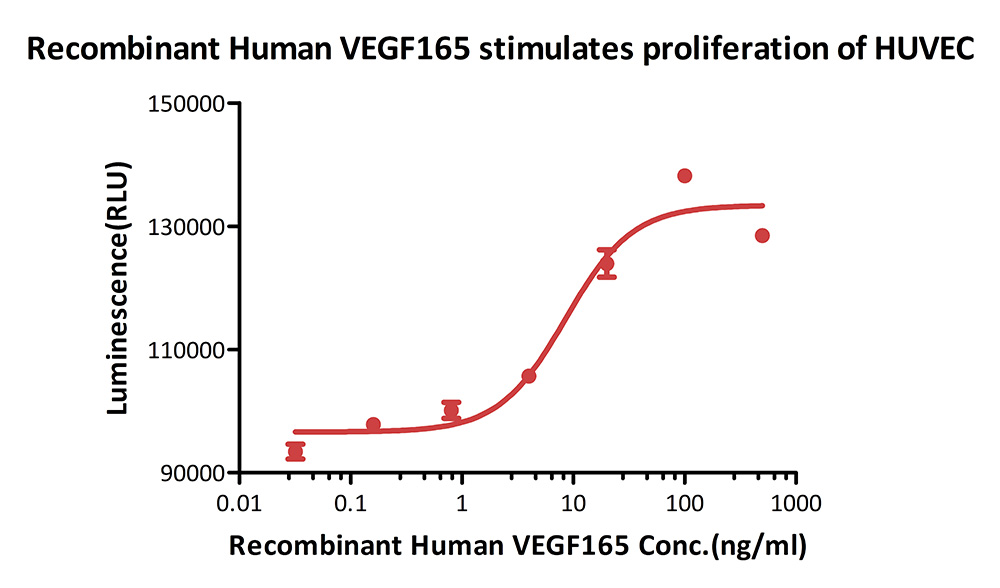
ActiveMax® Human VEGF165, Tag Free (MALS verified) (Cat. No. VE5-H4210) stimulates proliferation of human umbilical vein endothelial cells (HUVEC). The ED50 for this effect is 4.216-9.281 ng/mL (Routinely tested).
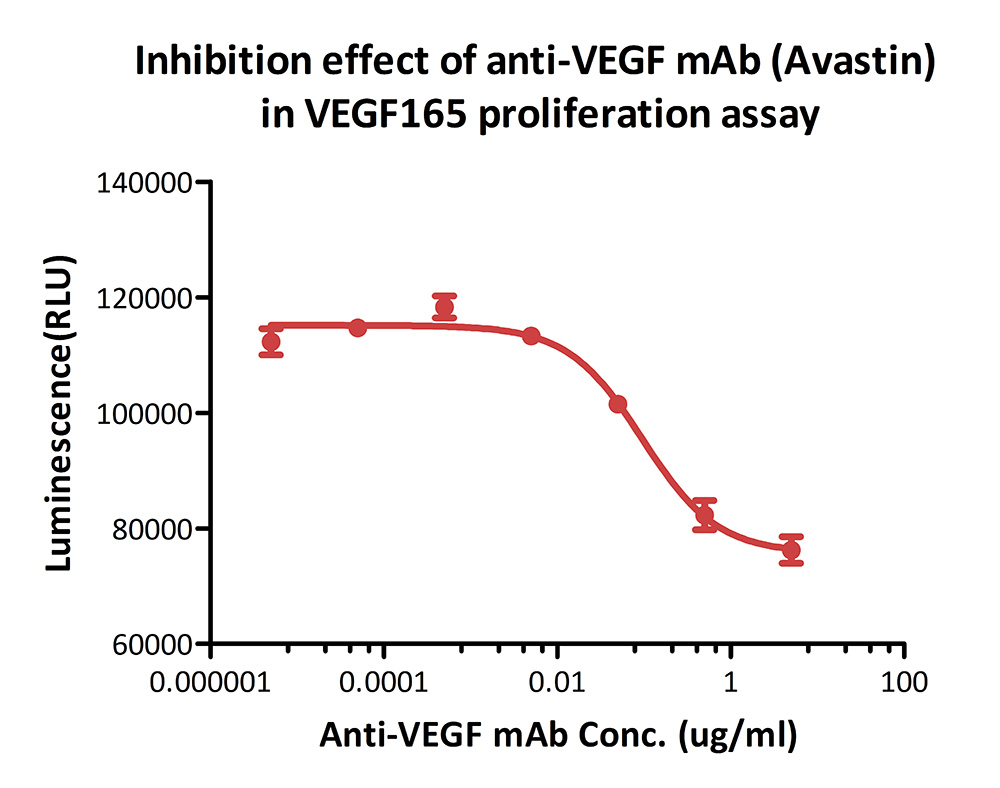
Inhibition assay shows that the proliferation effect of ActiveMax® Human VEGF165, Tag Free (MALS verified) (Cat. No. VE5-H4210) is inhibited by increasing concentration of anti-VEGF mAb (Avastin). The concentration of VEGF165 used is 20 ng/mL. The ED50 is 0.065-0.229 μg/mL (Routinely tested).
CHLOROTOXIN AGENTS AND USES THEREOF
Authors: Mcgonigle Sharon,Majumder Utpal,Postema Maarten H. D.
Cited Product: VE5-H4210
Journal: US20200206312A1 2020
Application: Binding Assay
CHLOROTOXIN AGENTS AND USES THEREOF
Authors: Mcgonigle Sharon,Majumder Utpal,Postema Maarten H. D.
Cited Product: VE5-H8210
Journal: US20200206312A1 2020
Application: Binding Assay
FGF primes angioblast formation by inducing ETV2 and LMO2 via FGFR1/BRAF/MEK/ERK
Authors: Chen PC, Hsueh YW, Lee YH, et al.
Cited Product: VE5-H4210
Journal: Cell Mol Life Sci 2020
Application: Flow cytometry
Authors: Meng Wang, Youke Qi, Yongning Sun
Cited Product: VE5-H5248
Journal: BioMed Research International 2020
Application: SPR
Biophysical characterization platform informs protein scaffold evolvability
Authors: Golinski AW, et al
Cited Product: VE1-H82E7
Journal: ACS COMB SCI 2019
Application: Binding Assay
Authors: F Corti, et al
Cited Product: VE5-H8210
Journal: Nat Commun 2019
Application: ELISA
Neuropilin-1 drives tumor-specific uptake of chlorotoxin
Authors: McGonigle S, et al
Cited Product: VE5-H8210
Journal: Cell Commun Signal 2019
Application: BLI
Methods of producing glycosylated proteins
Authors: ML Wetter, et al
Cited Product: VE5-H4210
Journal: US20180354997A1 2018
Application: SPR
Neuropilin-1 mediates Neutrophil Elastase uptake and cross-presentation in breast cancer cells
Authors: Kerros C, et al.
Cited Product: VE5-H5248
Journal: J Biol Chem 2017
Application: BLI
A biosynthetic route for polysialylating proteins in Escherichia coli
Authors: Keys TG, et al.
Cited Product: VE5-H4210
Journal: Metab Eng 2017
Application: SPR
In vitro Fab display: a cell-free system for IgG discovery
Authors: Stafford RL, et al.
Cited Product: VE1-H4213
Journal: Protein Eng Des Sel 2014
Application: SPR(Biacore T200)
This web search service is supported by Google Inc.








